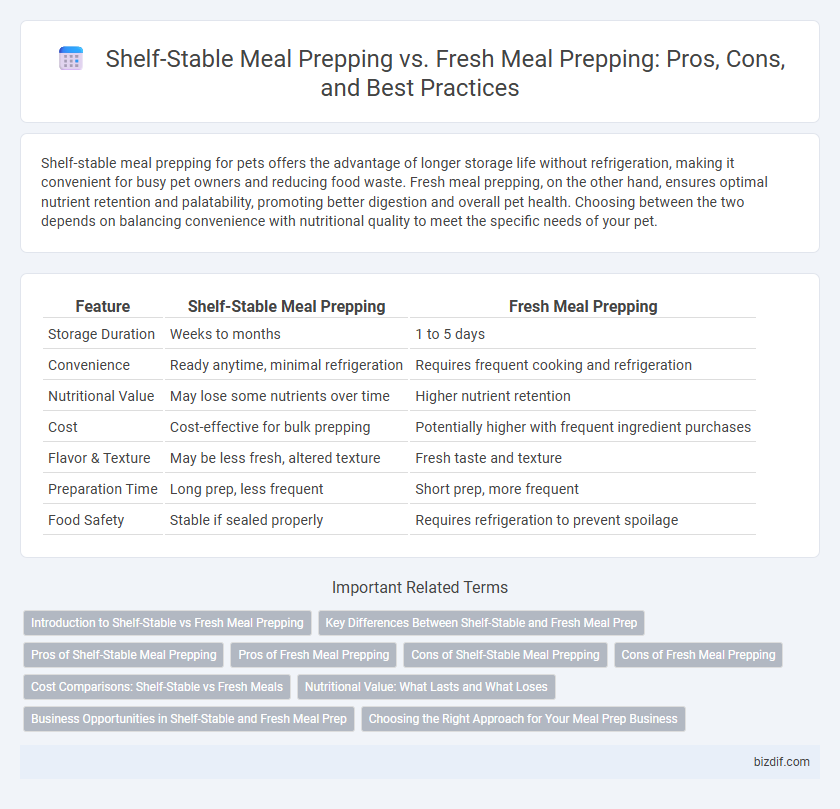Shelf-stable meal prepping for pets offers the advantage of longer storage life without refrigeration, making it convenient for busy pet owners and reducing food waste. Fresh meal prepping, on the other hand, ensures optimal nutrient retention and palatability, promoting better digestion and overall pet health. Choosing between the two depends on balancing convenience with nutritional quality to meet the specific needs of your pet.
Table of Comparison
| Feature | Shelf-Stable Meal Prepping | Fresh Meal Prepping |
|---|---|---|
| Storage Duration | Weeks to months | 1 to 5 days |
| Convenience | Ready anytime, minimal refrigeration | Requires frequent cooking and refrigeration |
| Nutritional Value | May lose some nutrients over time | Higher nutrient retention |
| Cost | Cost-effective for bulk prepping | Potentially higher with frequent ingredient purchases |
| Flavor & Texture | May be less fresh, altered texture | Fresh taste and texture |
| Preparation Time | Long prep, less frequent | Short prep, more frequent |
| Food Safety | Stable if sealed properly | Requires refrigeration to prevent spoilage |
Introduction to Shelf-Stable vs Fresh Meal Prepping
Shelf-stable meal prepping involves preparing meals that can be safely stored at room temperature for extended periods, using ingredients like canned goods, dried grains, and vacuum-sealed products, making it ideal for long-term storage and convenience. Fresh meal prepping relies on perishable ingredients such as fruits, vegetables, and proteins, emphasizing immediate consumption within a few days to maintain optimal taste and nutritional value. Choosing between shelf-stable and fresh meal prepping depends on factors like storage capacity, meal planning goals, and desired freshness.
Key Differences Between Shelf-Stable and Fresh Meal Prep
Shelf-stable meal prepping involves preparing meals that can be stored at room temperature for extended periods, using ingredients like canned goods, dried grains, and vacuum-sealed products. Fresh meal prepping focuses on using perishable ingredients such as vegetables, lean proteins, and dairy, requiring refrigeration and quicker consumption. Key differences include storage methods, nutritional preservation, shelf life, and convenience, with shelf-stable options offering longer storage and fresh meal prepping providing higher nutrient retention and flavor quality.
Pros of Shelf-Stable Meal Prepping
Shelf-stable meal prepping offers the advantage of extended storage without refrigeration, making it ideal for long-term planning and reducing food waste. These meals maintain nutritional value and flavor over time thanks to preservation techniques like dehydration and canning. Convenient for busy lifestyles, shelf-stable options enable easy portioning and quick meal access without compromising quality or safety.
Pros of Fresh Meal Prepping
Fresh meal prepping preserves higher nutrient content and vibrant flavors compared to shelf-stable options, enhancing overall meal quality. It allows for greater ingredient variety and customization tailored to dietary preferences and seasonal produce. Fresh prepping also minimizes reliance on preservatives and packaging, supporting healthier eating habits and reducing environmental impact.
Cons of Shelf-Stable Meal Prepping
Shelf-stable meal prepping often compromises nutritional quality due to the use of preservatives and additives that extend shelf life but reduce vitamins and minerals. The flavor and texture of shelf-stable meals tend to be inferior compared to fresh-prepped options, leading to a less satisfying eating experience. Moreover, reliance on packaged ingredients increases the risk of higher sodium and sugar content, which may negatively impact long-term health.
Cons of Fresh Meal Prepping
Fresh meal prepping often results in limited shelf life, increasing the risk of food spoilage and waste. It requires frequent cooking sessions to maintain freshness, which can be time-consuming and less convenient for busy schedules. Additionally, fresh meals typically demand more refrigeration space, posing a challenge for those with limited storage capacity.
Cost Comparisons: Shelf-Stable vs Fresh Meals
Shelf-stable meal prepping offers significant cost savings by reducing food waste and allowing bulk purchase of non-perishable items, whereas fresh meal prepping often involves higher expenses due to perishability and frequent grocery trips. The lower storage and preservation costs of shelf-stable ingredients contribute to an overall budget-friendly meal prep strategy. Fresh meals provide nutritional benefits but typically demand greater investment in both time and money to maintain quality and freshness.
Nutritional Value: What Lasts and What Loses
Shelf-stable meal prepping often retains macronutrients such as carbohydrates and fats but may lose some water-soluble vitamins like vitamin C and B-complex during processing and storage. In contrast, fresh meal prepping preserves higher levels of these sensitive nutrients and antioxidants but has a shorter shelf life due to enzymatic activity and microbial growth. Balancing nutrient retention with convenience requires selecting ingredients and storage methods tailored to specific dietary goals and timeframes.
Business Opportunities in Shelf-Stable and Fresh Meal Prep
Shelf-stable meal prepping offers significant business opportunities through extended product shelf life, reduced inventory waste, and expanded distribution channels, enabling companies to reach broader markets without the constraints of cold storage. Fresh meal prepping caters to growing consumer demand for high-quality, nutritious, and ready-to-eat options, fostering brand loyalty and premium pricing models in urban and health-conscious demographics. Both sectors benefit from innovations in packaging technology and supply chain optimization, driving scalability and enhanced customer satisfaction in the competitive food service industry.
Choosing the Right Approach for Your Meal Prep Business
Choosing between shelf-stable meal prepping and fresh meal prepping depends on your business goals, target market, and distribution capabilities. Shelf-stable meals offer longer storage life and reduced logistics costs, making them ideal for wider shipping ranges and bulk orders. Fresh meal prepping attracts health-conscious consumers seeking high-quality, perishable ingredients, requiring efficient cold chain management and faster delivery timelines.
Shelf-stable meal prepping vs fresh meal prepping Infographic

 bizdif.com
bizdif.com